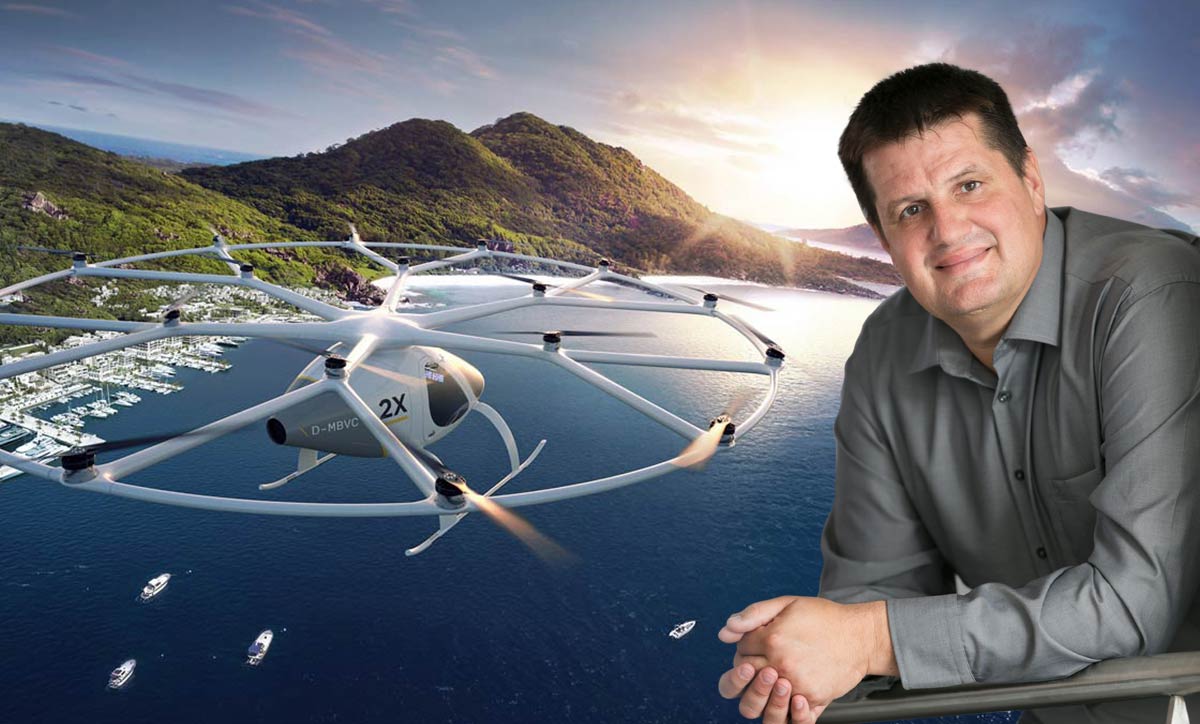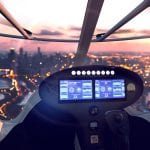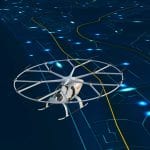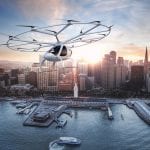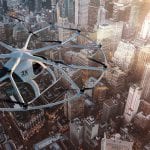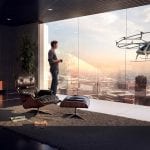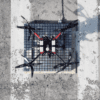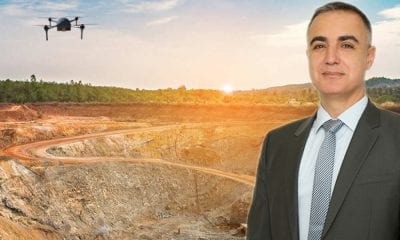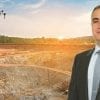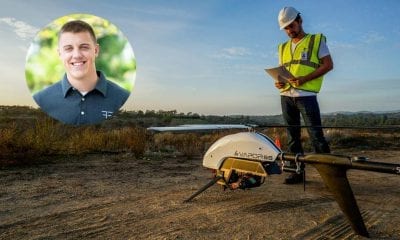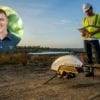Back to Base (B2B)
An Interview with Alex Zosel – Co-Founder of Volocopter GmbH
As drones disrupt everything from agriculture to defence, search and rescue to delivery, so are they entering the world of personal public transport. Last year we covered the first test flight in Dubai for the innovative air taxi by German air taxi company Volocopter, and more recently the announcement of Intel CEO Brian Krzanic’s flight as the first public passenger of a Volocopter at CES2018 this month. Here we dive deeper (or is that fly higher) with Alex Zosel, co-founder of Volocopter.
“The best way to predict the future is to invent it”. How does Volocopter do this? What makes it unique in the air taxi market?
At Volocopter we are pioneers of aviation. In 2011 we performed the first ever manned vertical take-off and landing of a completely electrically powered aircraft. In 2013, we had built our first two-seater prototype, which received a preliminary license in 2016. We have completed more than 500 flights, performed public demonstrations and had a steep learning curve over all these years. This gives us a first mover advantage.
What are the challenges involved in designing an autonomous system capable of taking off, landing, and carrying a human safely in an urban environment?
The most important task you have to fulfil is to create the safest aircraft possible. Commercial flight regulation is extremely strict – rightly so – and these we will comply to. So our first design concern is a very safe and stable flight. In an urban environment you fly over highly populated areas and have many micro turbulences around the buildings. As a means of public transport, the Volocopter needs to be able to counteract any turbulences in microseconds to ensure a smooth ride. Nobody wants to take a rollercoaster ride to work. Another concern is noise. In order to be accepted in cities, a soft sound signature is paramount. The Volocopter has the soothing low buzz of a bee hive.
What particular materials and technologies are used to address these challenges?
The Volocopter is filled with small sensors and processors to capture its environment. These only became so small and powerful thanks to the rise of smartphones over the past decade. As such the can measure the environment, calculate necessary actions and send them to the motors to adapt in real time. Our motors can perform those orders and adapt rotation speed in milliseconds as they are electronically powered. This makes the flight of the Volocopter so smooth. The airframe is a lightweight construction made of carbon.
Volocopter has impressively gained permission to fly by the notoriously strict German aviation authorities. How was this goal attained?
We knew from the beginning that we need to cooperate with the regulators to have a chance in becoming an accepted means of transport. So we worked closely together in defining the parameters needed for a whole new class of aircrafts. It seems to surprise everyone, but from day one we had great backing from the German authorities. Our airplane is by design much safer than any traditional helicopter – and as safety is the regulators highest concern, they are really excited to get our technology approved.
To have an effective flight range, the Volocopter carries a significant payload of batteries. How have you been able to make this commercially viable in terms of recharging?
Nobody wants to wait for 1,5h until their Volocopter is fully recharged. So we put in place a system of rechargeable batteries that can be switched out in just a few seconds.
Dubai’s plans to increase urban passenger travel by autonomous taxi to 25% by 2030 fits well with your company’s goals. Please tell us about Volocopter’s recent public flight there and where this chapter of the Volocopter story is headed.
We are technology partner of the RTA of Dubai for this project. Together we are defining the parameters needed in terms of regulation and infrastructure a city would need to implement a Volocopter Route. The first step in this partnership was to perform the public flight in September – goal of the cooperation is to have a route in place within 5 years – so by 2023. This is what we are now working on.
- Source: Volocopter
What is the path forward for making personal flight a common reality in urban areas? How does it integrate with existing air traffic regulations?
Regulators are very keen on working with us, as I mentioned above. Building the Air Taxi itself is however not the hardest challenge. You need to build the physical infrastructure of Volocopter hubs and ports and integrate with the public transport system. Another very important and often overlooked aspect is an air management system for the lower airspace to ensure the whole ecosystem is reliable and connected. Bright minds around the globe are working on solutions for the lower airspace making sure that in the future all cargo, camera, taxi, hobby drones know where they are flying and communicate with each other about changing obstacle such as construction cranes.
What are the possibilities for autonomous public air transport in the future?
In the future autonomous air taxis will be integrated in the general public transport scheme. Wherever you are you will put origin and destination into your phone and will be presented with different means to get there. Some more affordable, but slower. Some a little more expensive and faster.
We expect the first Volocopter routes to be alleviating high traffic bottlenecks such as bridges or tunnels as point to point connections. More routes will be added and connected with one another. One of the great advantages with Volocopters is that they can provide infrastructure on demand. They can connect the city centre to the airport, but when there is an important game on, they connect the city centre to the stadium. All it takes is a Voloport.
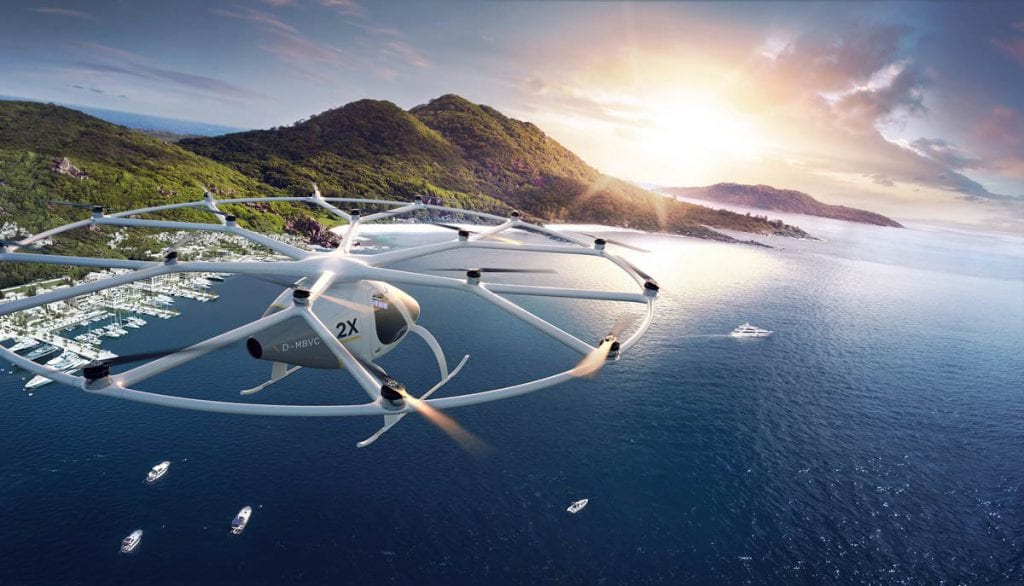
What will 2018 bring for Volocopter?
2018 will be filled with new milestones developing our aircraft further, building up a small fleet and defining further what the whole Volocopter ecosystem will look like.
Anything else you’d like to add?
Volocopters are coming and they will be operating commercially much sooner than anybody thinks.
About Alex Zosel – Co-founder of Volocopter GmbH.
 In 1981, aged just 15, he construed and built one of the first skateboard half-pipes in Germany together with a few friends. Whilst studying for his degree in civil engineering he developed his first patent and in his capacity as ‘Serial Entrepreneur’ and self made man he is now an entrepreneur through and through. With his enthusiasm and his firm belief in his vision regarding mobility of the future in the third dimension he brings much innovative buzz to the whole team.
In 1981, aged just 15, he construed and built one of the first skateboard half-pipes in Germany together with a few friends. Whilst studying for his degree in civil engineering he developed his first patent and in his capacity as ‘Serial Entrepreneur’ and self made man he is now an entrepreneur through and through. With his enthusiasm and his firm belief in his vision regarding mobility of the future in the third dimension he brings much innovative buzz to the whole team.

